Overview
The article emphasizes the critical need for effective strategies in the successful integration of hybrid energy corridors. It highlights the role of advanced technologies, stakeholder collaboration, and supportive government policies in enhancing operational efficiency and facilitating the development of renewable energy. This approach is essential in addressing the growing demand for sustainable power solutions.
Introduction
The escalating demand for sustainable energy solutions has catalyzed a notable increase in hybrid energy corridor integration. This strategic approach amalgamates various renewable resources to bolster energy efficiency and reliability. This article explores seven essential strategies that can facilitate successful integration, underscoring the pivotal roles of advanced technologies, government policies, and stakeholder collaboration. As the quest for clean energy intensifies, how can stakeholders adeptly navigate the intricate challenges of land acquisition and regulatory frameworks to ensure the flourishing of these innovative energy corridors?
Harbinger Land | Comprehensive Solutions for Land Services in Energy and Infrastructure
Harbinger Land stands at the forefront of extensive land services, uniquely positioned to address the complexities of utility and infrastructure projects. The challenges of land acquisition are multifaceted, encompassing legal and regulatory hurdles that demand robust negotiation skills and a deep understanding of the landscape. Harbinger Land's expertise in site and right-of-way acquisition, title research, GIS mapping, and data processing ensures that these challenges are met with precision and efficiency.
By leveraging cutting-edge technology, including AI-powered title research software and highly integrated GIS modeling services, Harbinger Land significantly enhances operational efficiency and client satisfaction. This technological edge not only streamlines processes but also solidifies their role as a crucial ally in hybrid energy corridor integration across the United States.
As the energy sector braces for a surge, with projections indicating that this power source will account for nearly 60% of all new utility-scale electricity-generating capacity in 2024, the need for effective land acquisition strategies becomes increasingly critical. Successful strategies hinge on a comprehensive understanding of the regulatory landscape, ensuring that projects are not only feasible but also aligned with environmental and social governance (ESG) standards.
Furthermore, the renewable energy sector is experiencing remarkable growth, with an average annual rate of 28% over the past decade. This underscores the urgency for effective land acquisition strategies that can adapt to evolving market demands. By utilizing advanced document imaging solutions that digitize property data, Harbinger Land simplifies title research, paving the way for sustainable development in the sector. In a landscape where effective land acquisition is paramount, partnering with Harbinger Land ensures that your projects are positioned for success.
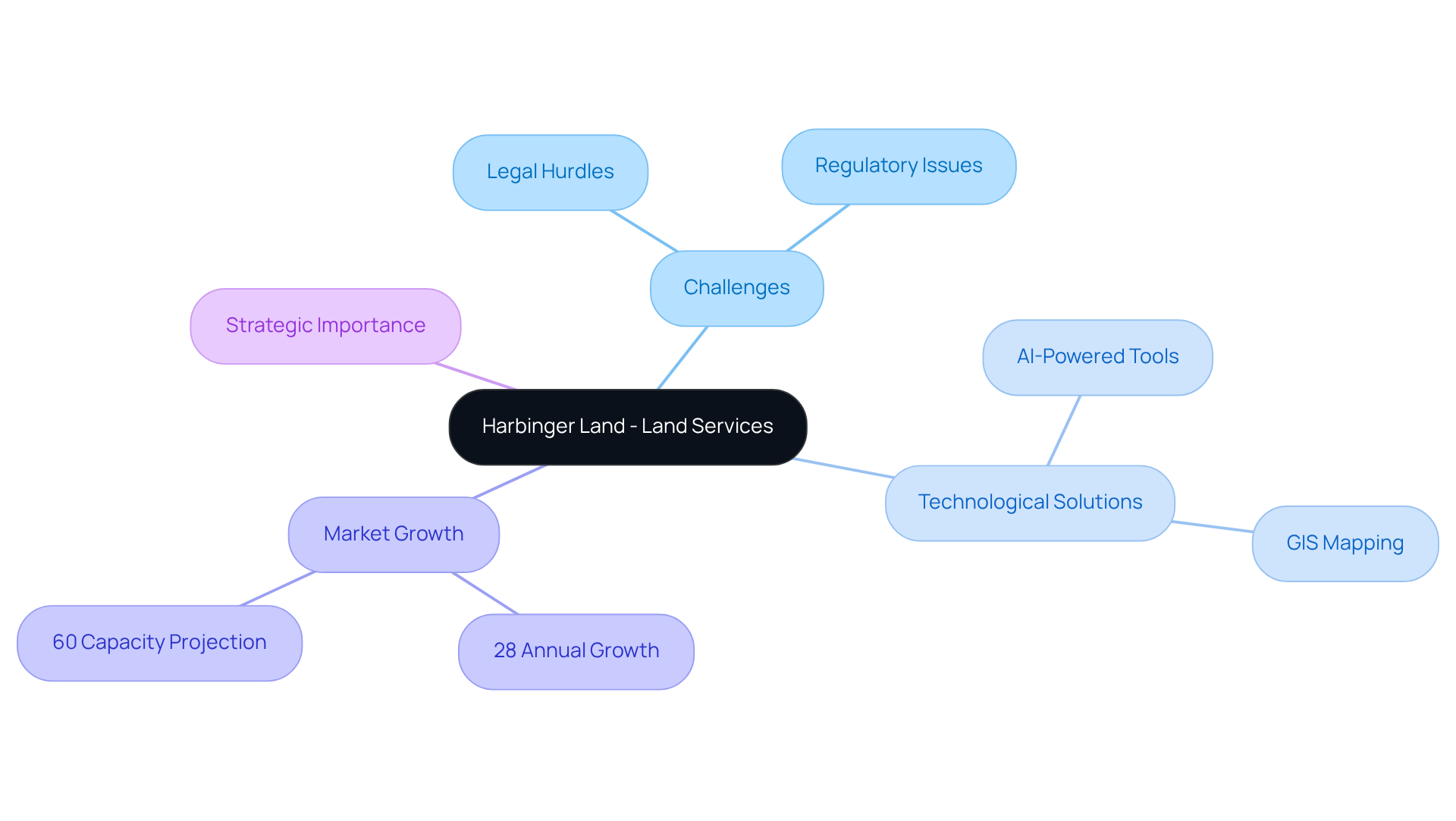
National Solar Mission: Driving Renewable Energy Growth
The National Solar Mission stands as a cornerstone in establishing India as a global leader in solar energy, actively fostering the development of power plants throughout the country. This initiative has led to a significant increase in photovoltaic capacity, with projections indicating that by 2025, India will have substantially improved its installations, paving the way for a cleaner energy landscape. The mission not only attracts investments but also drives technological advancements, rendering renewable energy more accessible and efficient.
By advocating for hybrid energy corridor integration of renewable resources, the National Solar Mission plays a vital role in sustainable energy development while reducing dependence on fossil fuels. This strategic direction aligns with the overarching goal of achieving energy security and environmental sustainability. As Bernie Sanders aptly noted, the transition to renewable energy is not only beneficial for the environment but also economically advantageous, with the potential to create jobs and stimulate local economies.
The mission's success is evidenced by the increasing number of photovoltaic projects and the growing recognition of solar energy's role in meeting India's power demands. For instance, California recently demonstrated the potential of energy integration by sourcing nearly 40 percent of its electricity from solar power on March 11. Furthermore, Rajendra Pachauri emphasizes the extraordinary long-term prospects of solar energy, underscoring the importance of the National Solar Mission in fostering a sustainable energy future.
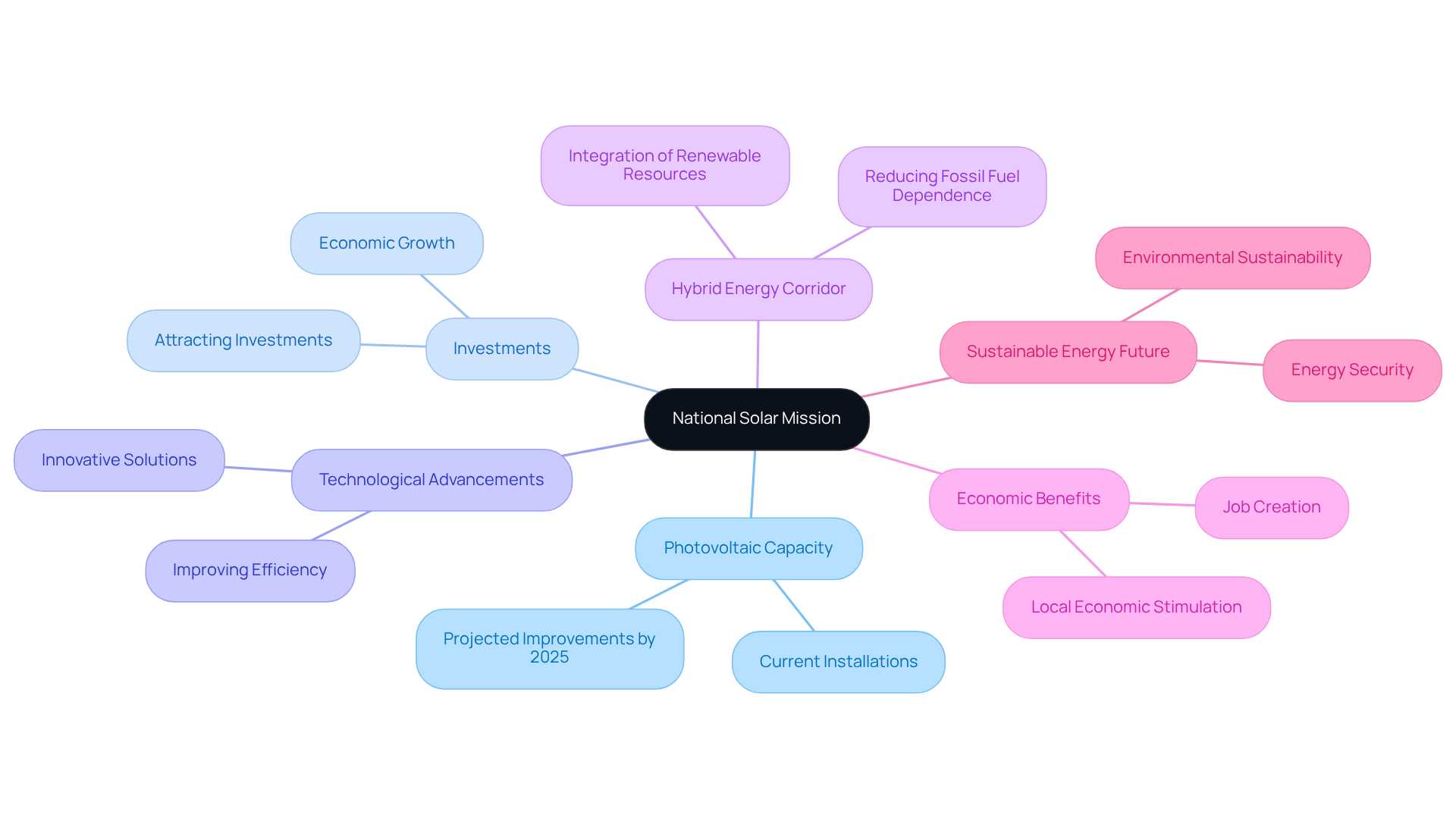
PLI Scheme for Solar PV Manufacturing: Boosting Solar Energy Production
The Production Linked Incentive (PLI) Scheme for photovoltaic manufacturing serves as a pivotal initiative aimed at bolstering domestic production of solar panels. This scheme is designed to significantly reduce reliance on imports while enhancing local manufacturing capabilities. By promoting the generation of solar power, the PLI Scheme plays a crucial role in the hybrid energy corridor integration, which helps in developing diversified energy pathways and ensuring a reliable supply of sustainable power. This strategic move not only strengthens the energy sector but also positions the country as a leader in renewable energy production.
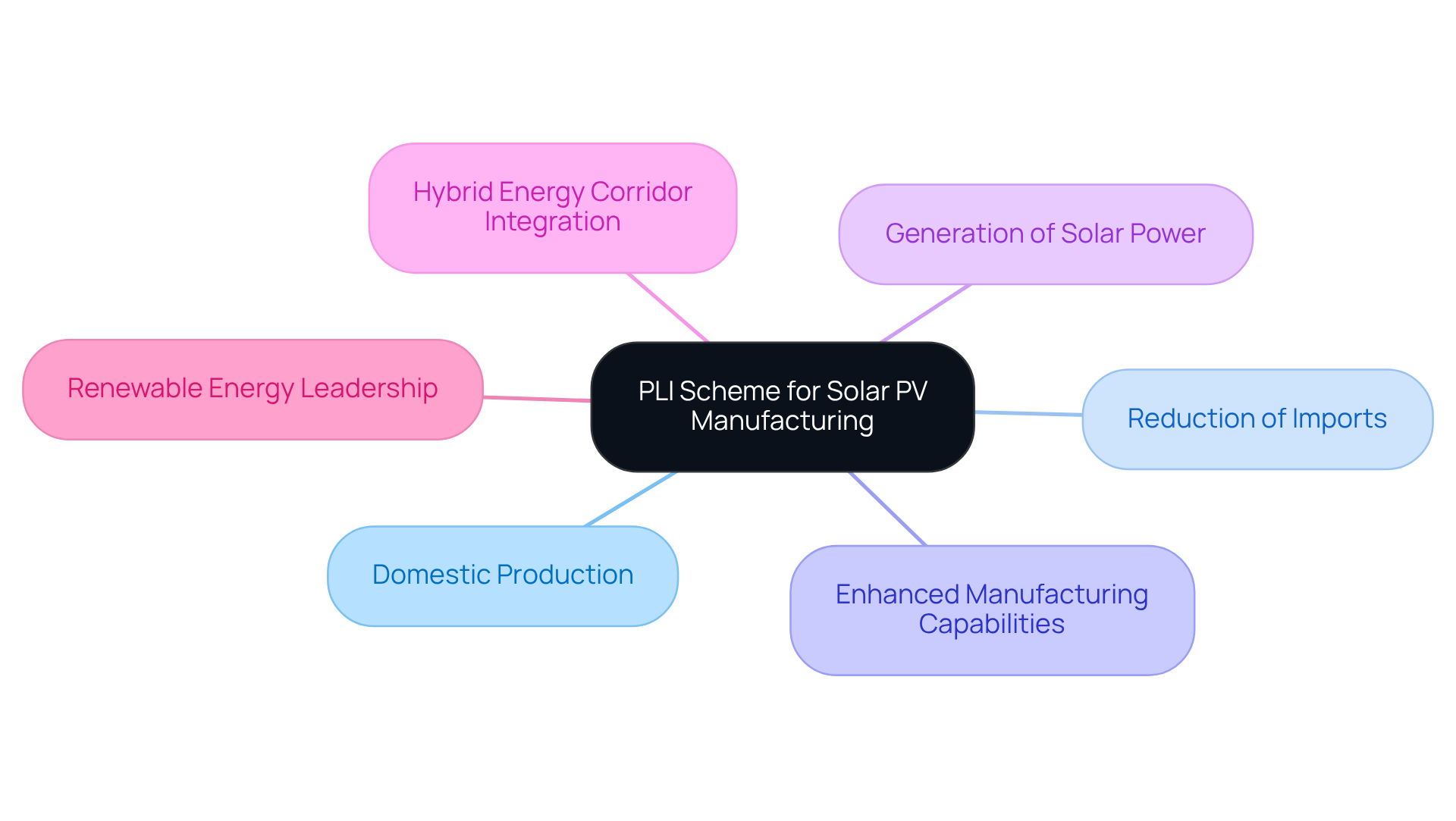
National Wind-Solar Hybrid Policy: Facilitating Energy Integration
The National Wind-Solar Hybrid Policy is critical in fostering the co-location of wind and solar projects, significantly enhancing power generation efficiency and resource utilization. By advocating for hybrid energy corridor integration of these renewable sources, the policy bolsters the viability of combined power pathways and contributes to a more stable and reliable power supply. Co-located systems largely function independently behind a single interconnection point, thereby optimizing operational efficiency. This approach not only promotes better land utilization but also minimizes environmental impacts while maximizing power output.
Recent data indicates that hybrid plants accounted for nearly 49 GW of generating capacity in the U.S. by the end of 2023, with hybrid systems incorporating 3.6 GW/11.1 GWh of power storage. This reflects substantial growth in both power generation and storage capabilities. The successful execution of this policy is evident across various regions, where the hybrid energy corridor integration of wind and solar has significantly enhanced energy independence and resilience against fluctuations in energy demand.
Furthermore, co-locating these initiatives can lead to reduced overall costs and streamlined permitting processes, making it an attractive option for developers and stakeholders alike. However, it is crucial to acknowledge that 23% of the area encounters environmental challenges due to unsuitability, underscoring the complexities associated with mixed project development.
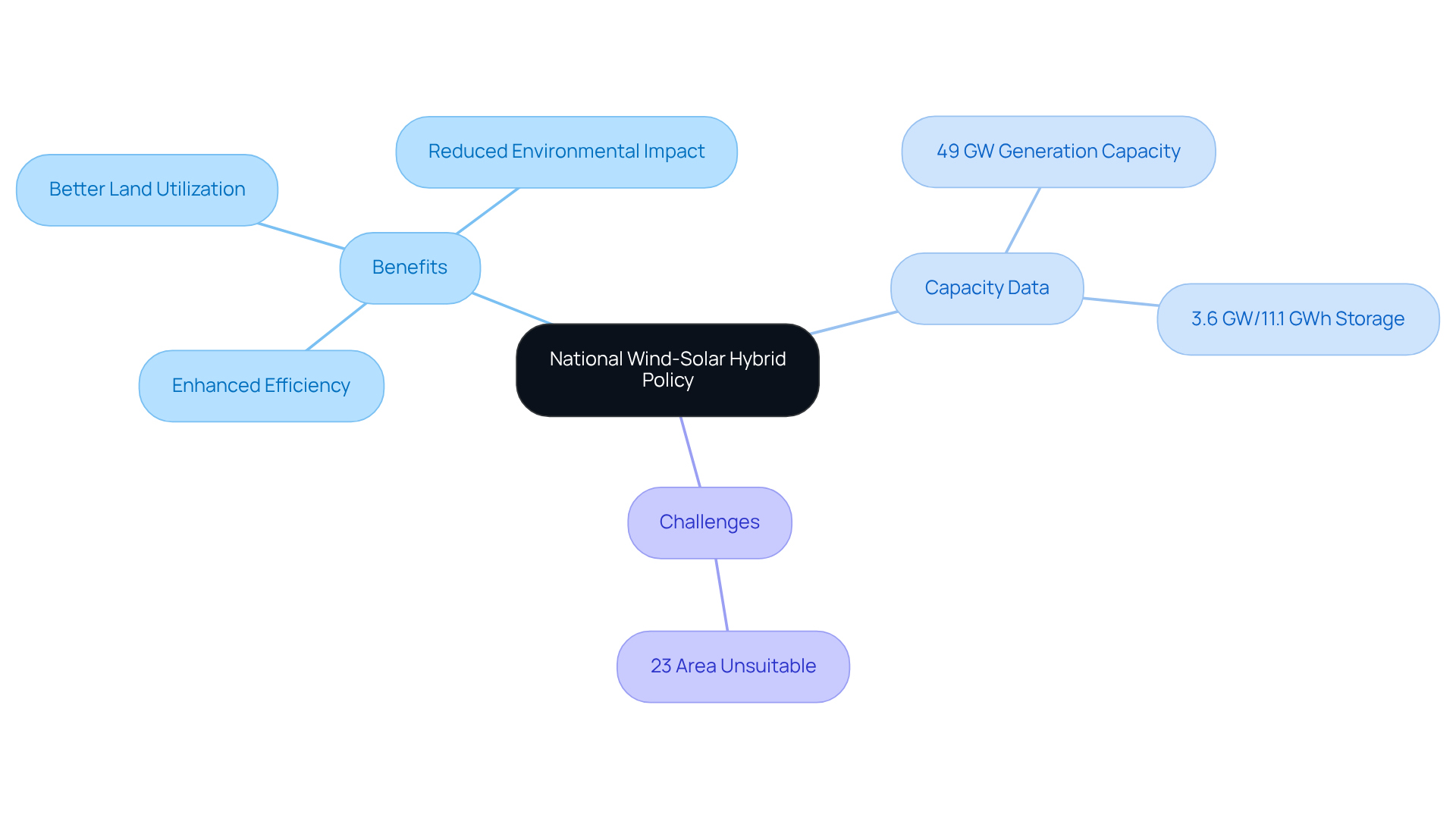
Green Energy Corridor Scheme: Enhancing Energy Transmission
The Green Energy Corridor Scheme stands as a pivotal initiative in establishing a robust transmission infrastructure, facilitating the seamless transfer of renewable resources from generation sites to consumption areas. By significantly enhancing power transmission capabilities, this initiative not only supports hybrid energy corridor integration but also ensures the efficient utilization of generated electricity.
Recent findings from the Levelized Cost of Electricity Report reveal that solar and onshore wind have emerged as the most cost-effective sources of new power in the U.S., underscoring the economic viability of investing in renewable resources. Furthermore, clean power policies are yielding substantial savings for households, with average annual savings ranging from $235 to $282, as highlighted in the case study on the affordability of clean power.
This trend underscores the critical role of transmission infrastructure in enabling the distribution of renewable resources, ultimately contributing to a more sustainable and economically advantageous landscape. A robust renewable power sector not only benefits the environment but also stimulates economic growth, making it essential for future development.
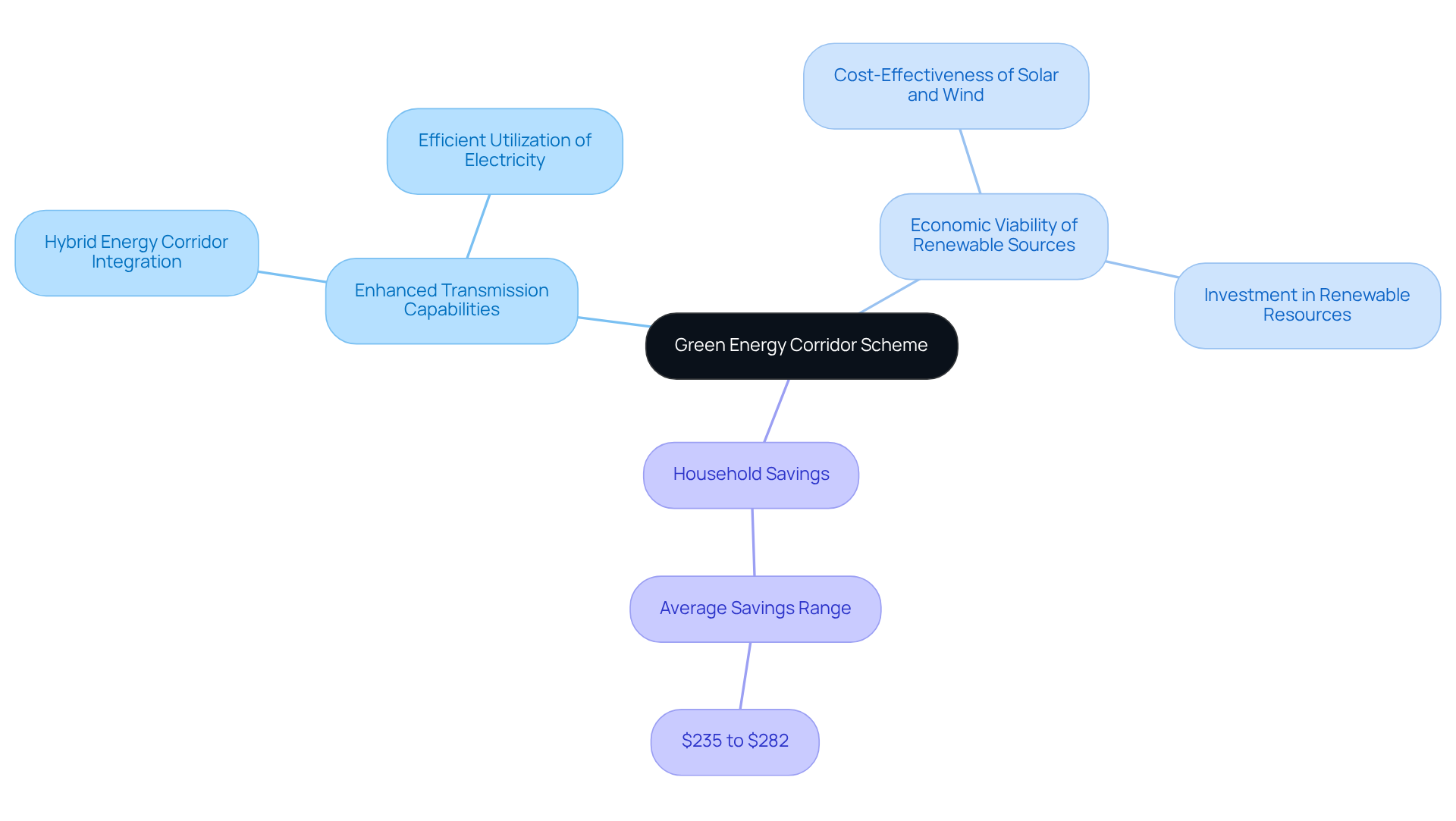
Viability Gap Funding Scheme: Supporting Sustainable Projects
The Viability Gap Funding (VGF) Scheme is pivotal in advancing infrastructure projects that, despite their economic justification, face challenges in attracting commercial investment. By providing essential grants and subsidies, the VGF scheme alleviates significant financial hurdles, facilitating hybrid energy corridor integration. This initiative is particularly vital in light of the growing demand for sustainable power solutions.
For example, the government has earmarked ₹5,400 crore to support 30 GWh of Battery Energy Storage Systems (BESS), with an additional 13.2 GWh of BESS already in the implementation phase. This financial backing is expected to attract an investment of ₹33,000 crore, enhancing the viability of renewable initiatives while fostering innovation and growth within the sector.
Furthermore, the increase in compensation for tower area from 85% to 200% of land value underscores the financial support aspect of the VGF scheme, which is crucial for land acquisition strategies in renewable projects. Harbinger Land's expertise in site and right-of-way acquisitions, utilizing advanced GIS modeling services, guarantees efficient easements that save clients both time and money, thereby bolstering the successful execution of these projects.
As the power generation landscape transforms, the VGF scheme emerges as a critical mechanism for ensuring the success of hybrid energy corridor integration, ultimately contributing to a more sustainable energy future.
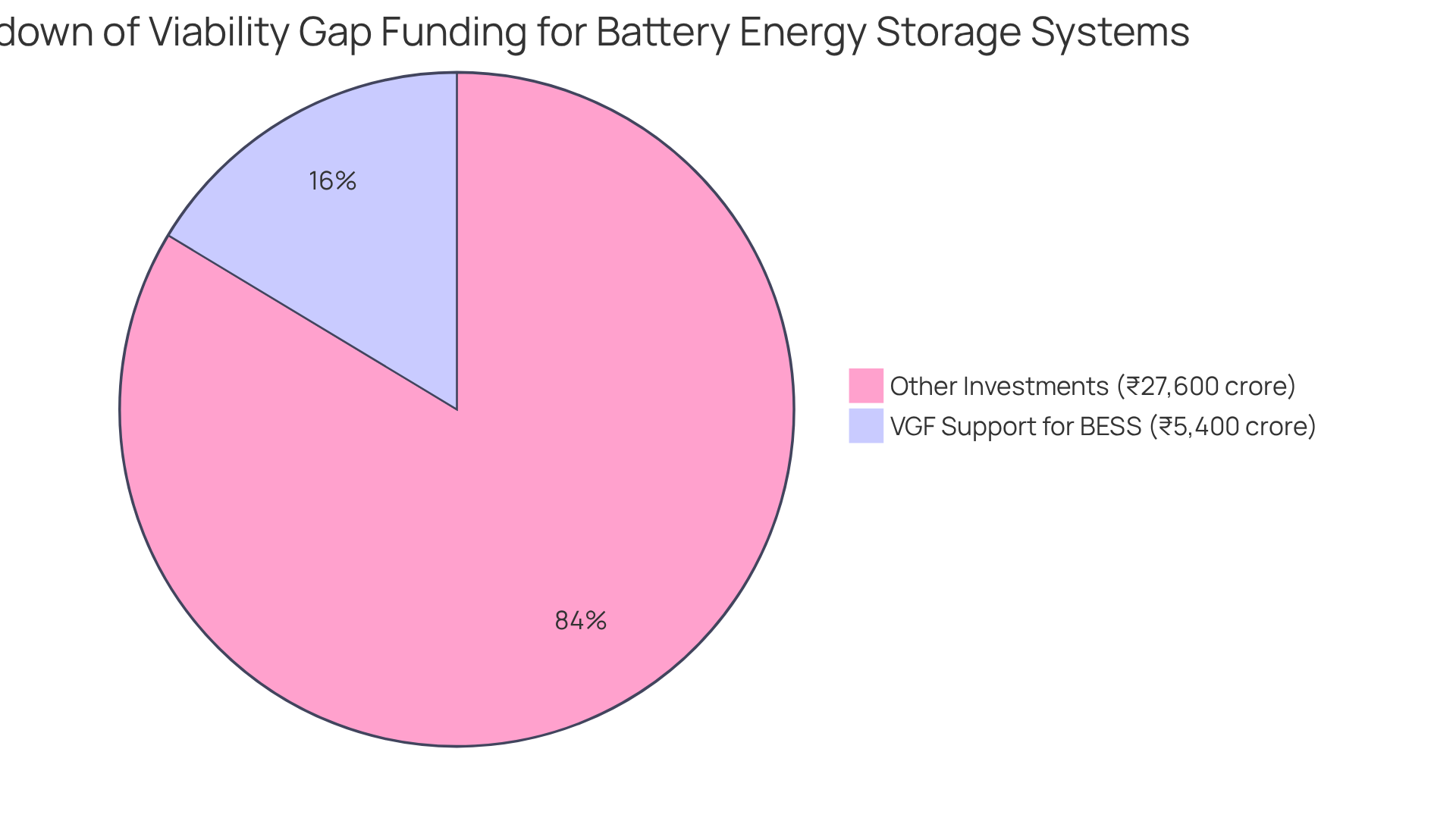
Advanced GIS Mapping: Optimizing Land Acquisition Processes
Advanced GIS mapping technology significantly enhances the land acquisition process. By providing detailed spatial analysis and visualization tools, this technology allows stakeholders to accurately identify suitable land parcels. It also facilitates the evaluation of environmental impacts and streamlines the acquisition process. As a result, it promotes hybrid energy corridor integration, addressing the complexities often encountered in land acquisition.
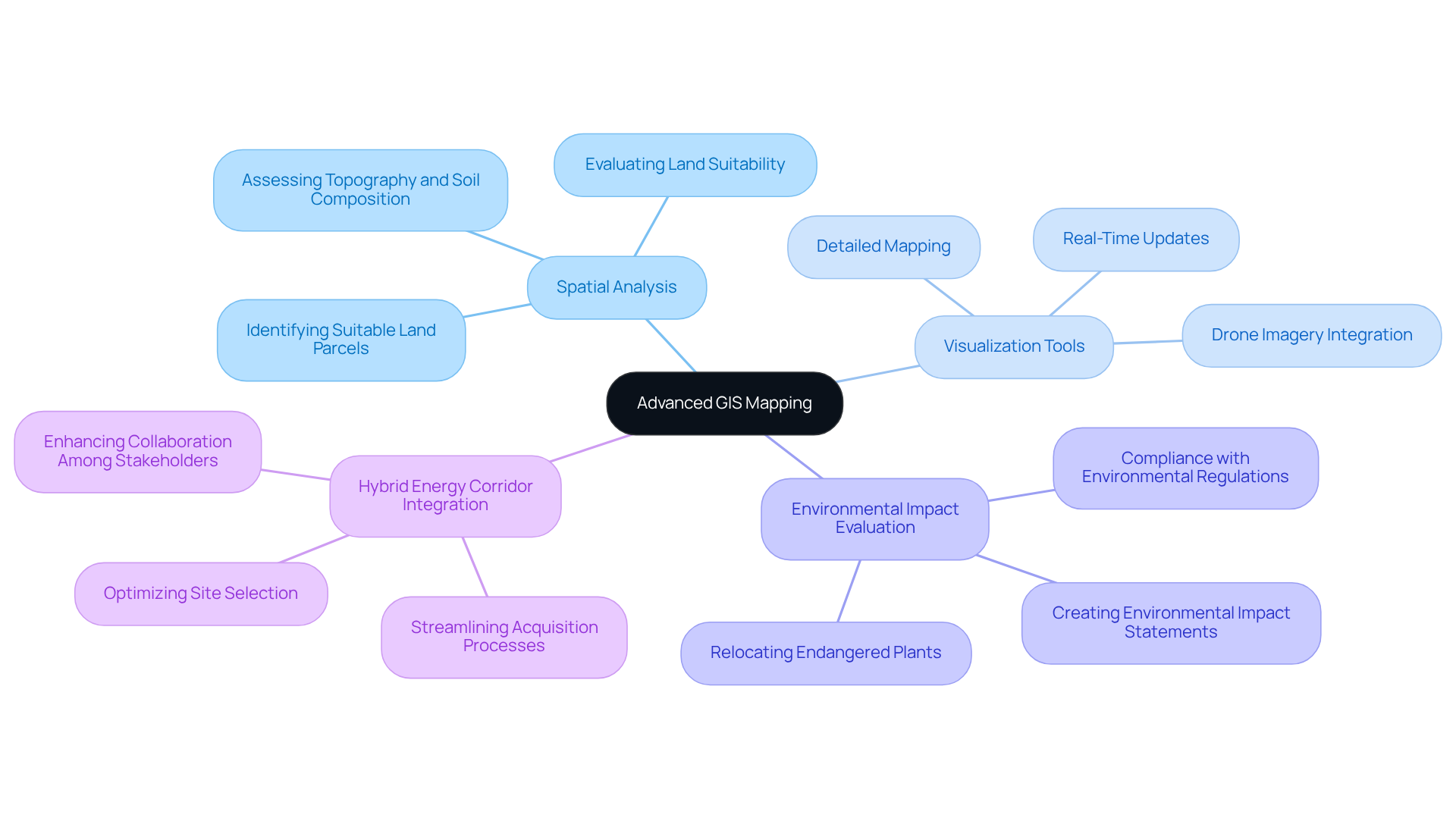
Stakeholder Collaboration: Key to Successful Corridor Integration
The successful hybrid energy corridor integration is fundamentally dependent on robust collaboration among diverse stakeholders, including government agencies, private developers, and local communities. Effective stakeholder involvement is crucial for recognizing and addressing the interests of various parties, cultivating trust and facilitating seamless implementation. For example, the Lake Turkana Wind Power Initiative in Kenya demonstrates how extensive community development efforts can mitigate resistance and enhance acceptance. By prioritizing open communication and actively involving stakeholders in decision-making processes, initiatives can navigate challenges more effectively.
Moreover, strategic collaborations can stimulate innovation and resource sharing, significantly enhancing the success rate of hybrid corridor initiatives. Case studies, such as Chevron's Gorgon Gas Initiative, illustrate that early engagement with Indigenous groups not only addresses environmental concerns but also ensures compliance with local regulations, underscoring the importance of compliance risk management in energy projects. Furthermore, implementing Corporate Social Responsibility (CSR) initiatives can improve community acceptance and generate long-term benefits.
This collaborative approach not only enhances outcomes but also aligns with global sustainability goals, including those outlined in the Paris Agreement. In summary, fostering a culture of collaboration and transparency, along with effective stakeholder mapping and analysis, is essential for the successful hybrid energy corridor integration, ultimately leading to sustainable and resilient power systems.
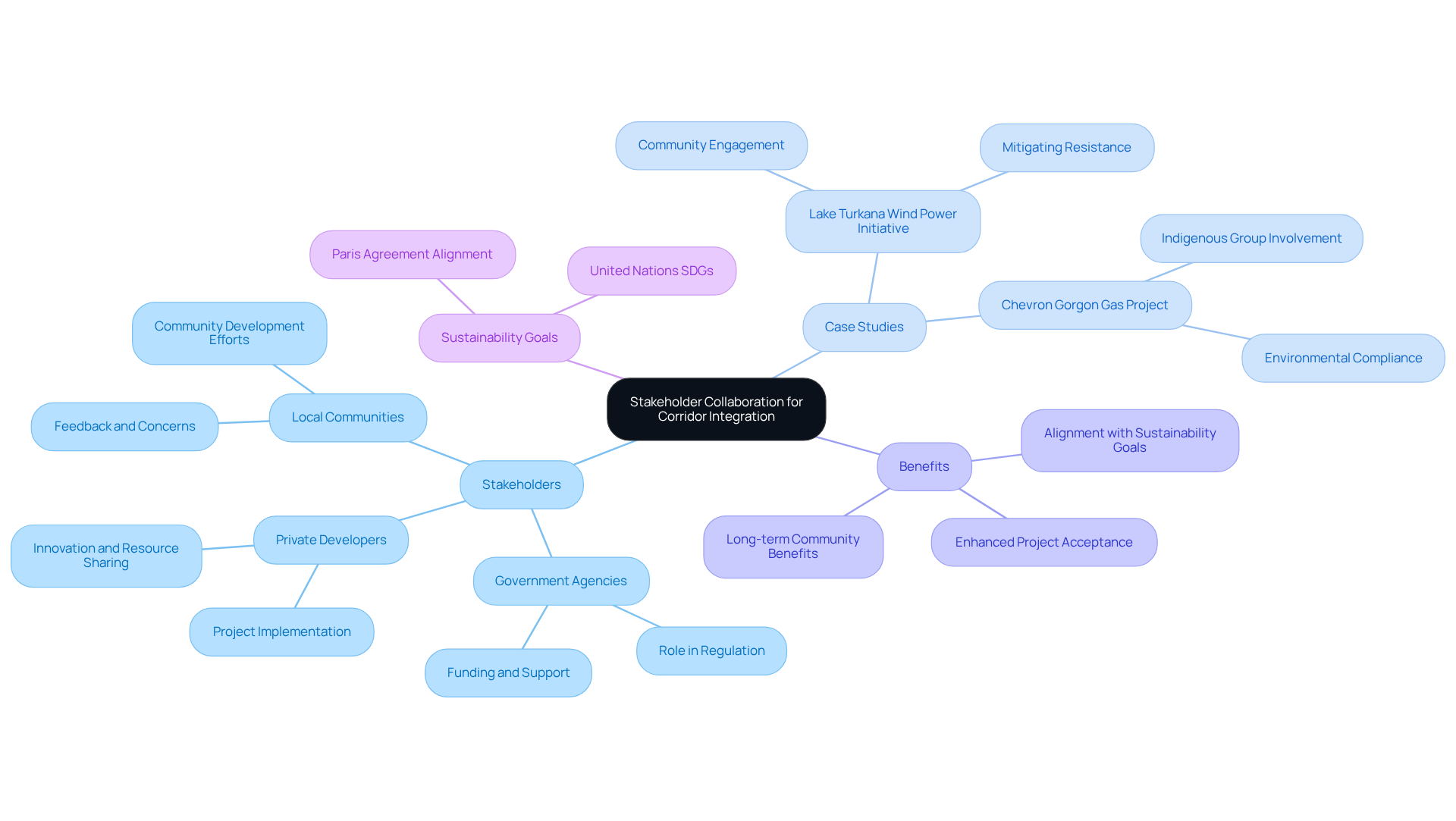
Government Policies: Fueling Renewable Energy Growth
Government policies play a crucial role in driving the growth of renewable resources by providing a variety of incentives, subsidies, and regulatory frameworks that facilitate project development. These initiatives create a supportive environment for hybrid energy corridor integration and stimulate significant investment and innovation within the renewable sector. For example, the U.S. Department of Energy's Greenhouse Gas Reduction Fund, which has a budget of $27 billion, is expected to enable the deployment of over 36 GW of renewables and storage by 2030.
Moreover, while the levelized cost of electricity (LCOE) for utility-scale photovoltaic and wind has consistently remained lower than that of fossil fuels, it is important to recognize that this trend has seen an increase in LCOE during 2023 and 2024, reflecting current market conditions. In 2024, solar capacity growth surged by 88%, underscoring the positive effects of these incentives. Additionally, a Deloitte survey revealed that 97% of utilities prioritize clean power to meet the rising demand from data centers, demonstrating the effectiveness of government support in shaping the energy landscape.
As combined power initiatives focused on hybrid energy corridor integration continue to gain traction, the influence of these regulations will be vital in ensuring their success and sustainability.
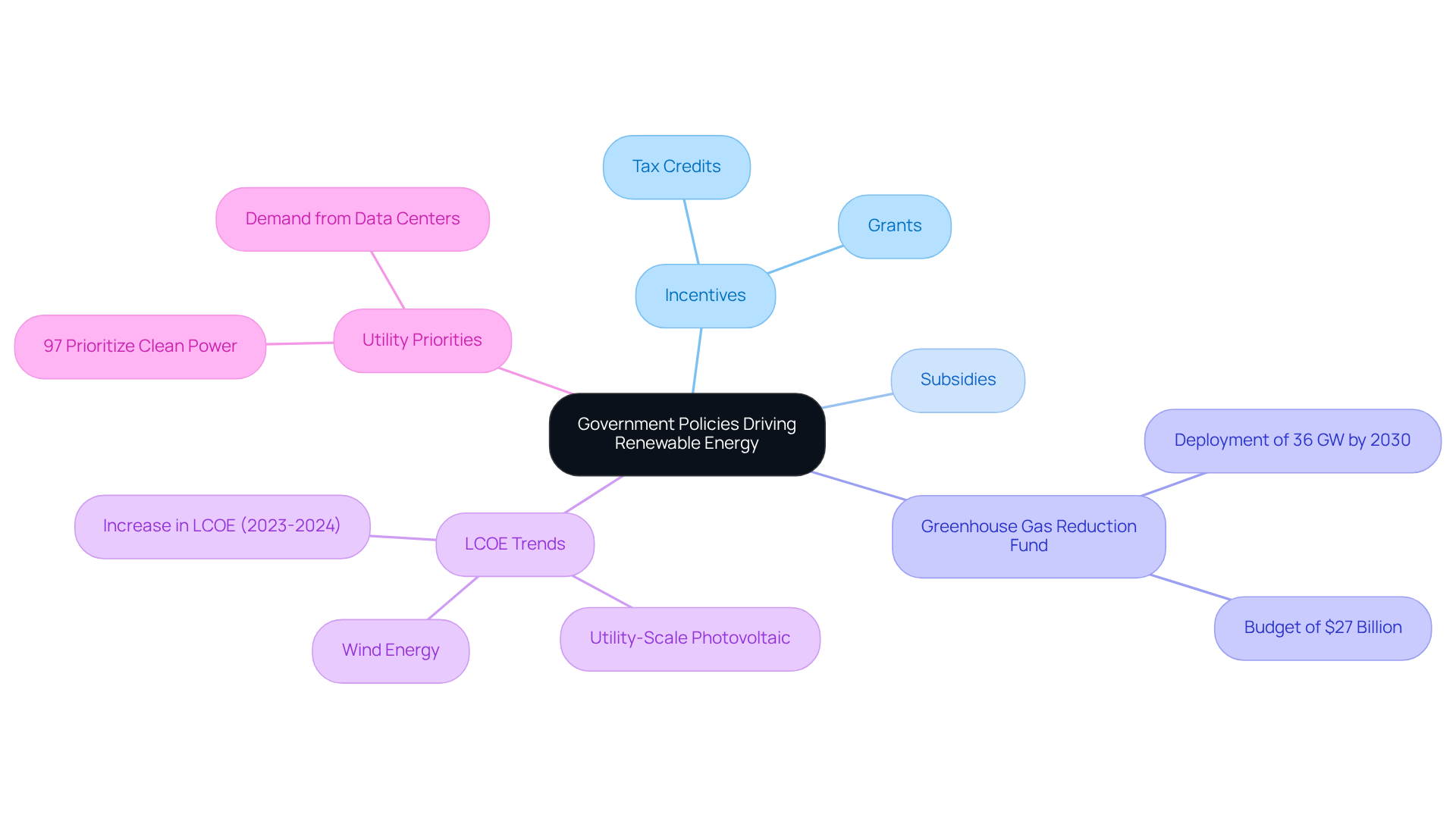
Key Takeaways: Benefits of Hybrid Energy Corridor Integration
Incorporating mixed power pathways presents a compelling solution to today's energy challenges, offering numerous benefits such as enhanced security, substantial decreases in carbon emissions, and improved resource utilization. By utilizing diverse renewable power sources, these corridors ensure a stable and dependable supply, critical for sustainable development and economic growth. For instance, hybrid systems can significantly reduce carbon footprints by efficiently integrating sunlight and wind power with storage solutions, effectively addressing intermittency challenges and enhancing grid stability.
As of 2023, the levelized cost of electricity for solar PV was 56% lower than fossil fuel alternatives, underscoring the economic viability of these initiatives. Successful implementations, such as the Mohave Electric Cooperative project, illustrate how AI-driven management tools can optimize resource dispatch during peak demand, thereby enhancing overall system efficiency. The hybrid energy corridor integration not only supports U.S. power independence but also aligns with global sustainability objectives, positioning combined power corridors as a crucial element in the transition to a cleaner future.
Moreover, with worldwide power usage anticipated to rise by approximately 30.1% by 2040, the necessity for combined power solutions becomes increasingly evident. Improvements in battery technology further enhance the feasibility of these systems, ensuring they can meet future power requirements effectively. As Paul Polman aptly noted, renewable energy not only reduces emissions but also creates jobs, highlighting the socio-economic benefits of hybrid energy corridor integration.
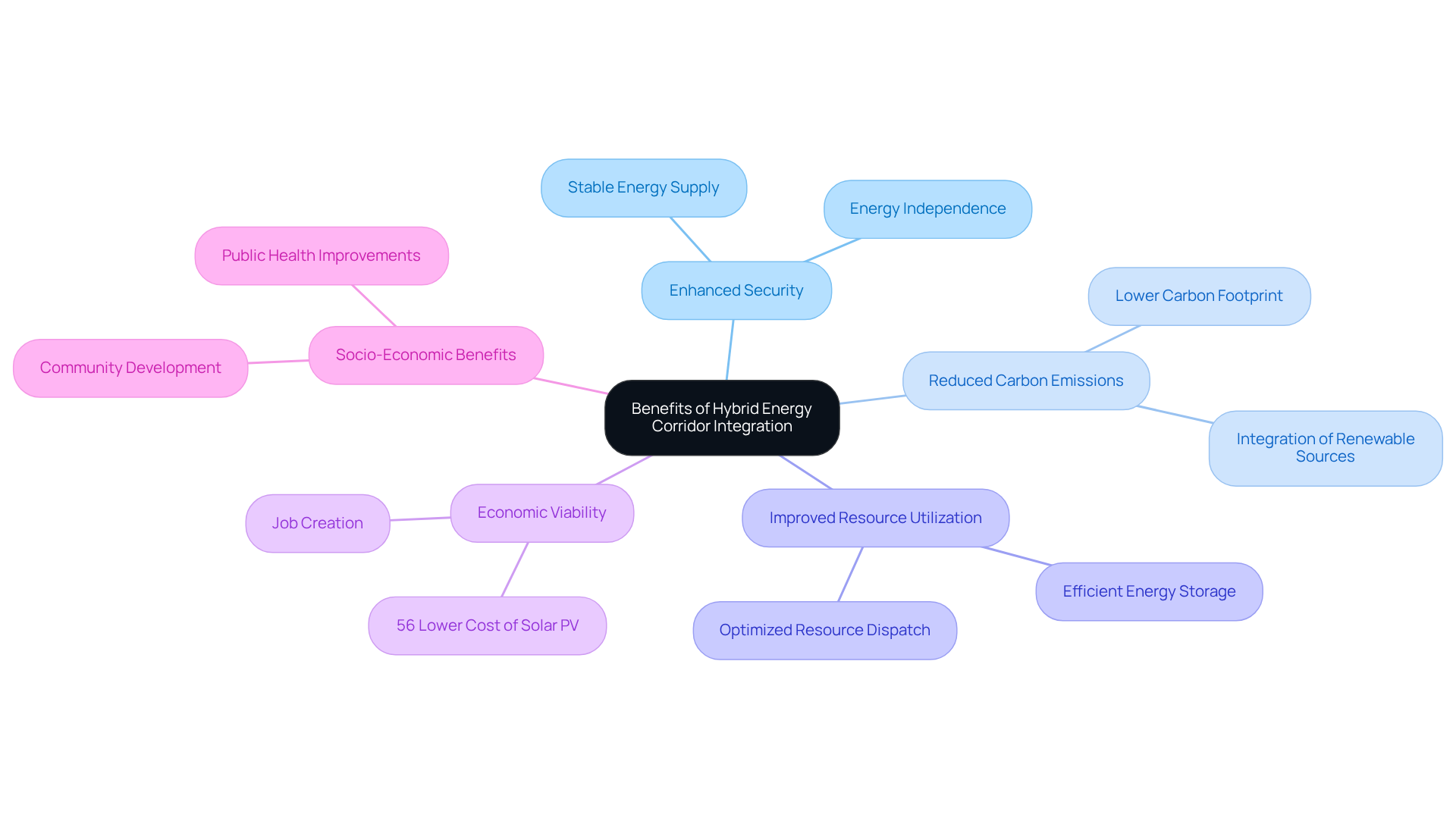
Conclusion
The integration of hybrid energy corridors stands as a pivotal solution to the escalating energy demands while championing sustainability. By merging diverse renewable resources, these corridors not only bolster energy security but also play a crucial role in diminishing carbon emissions and optimizing resource utilization, thereby laying the groundwork for a cleaner and more resilient energy future.
The article underscores essential strategies for the effective integration of hybrid energy corridors. These strategies encompass:
- The utilization of advanced technologies such as GIS mapping for streamlined land acquisition
- The significance of government policies in nurturing renewable energy expansion
- The indispensable role of stakeholder collaboration in ensuring project success
Each component is integral to establishing a solid framework for the effective integration of renewable energy sources.
Given the pressing need for sustainable energy solutions, it is imperative for stakeholders—governments, developers, and communities—to prioritize initiatives surrounding hybrid energy corridors. By fostering collaboration and adopting innovative practices, the shift towards a more sustainable energy landscape can be expedited, guaranteeing that future generations reap the benefits of cleaner, more dependable energy sources. Engaging in these initiatives not only addresses immediate energy challenges but also aligns with global sustainability objectives, reinforcing the significance of hybrid energy corridors within the broader context of environmental stewardship and economic resilience.
Frequently Asked Questions
What services does Harbinger Land provide?
Harbinger Land offers extensive land services focused on utility and infrastructure projects, including site and right-of-way acquisition, title research, GIS mapping, and data processing.
How does Harbinger Land enhance operational efficiency?
Harbinger Land utilizes cutting-edge technology, such as AI-powered title research software and integrated GIS modeling services, to streamline processes and improve client satisfaction.
Why is effective land acquisition crucial in the energy sector?
Effective land acquisition is critical due to the complexities of legal and regulatory challenges, especially as the energy sector anticipates significant growth, with projections indicating that renewable energy will account for nearly 60% of new utility-scale electricity-generating capacity in 2024.
What is the National Solar Mission?
The National Solar Mission is an initiative aimed at establishing India as a global leader in solar energy by fostering the development of power plants and significantly increasing photovoltaic capacity.
How does the National Solar Mission contribute to renewable energy?
The mission drives technological advancements, attracts investments, and promotes hybrid energy corridor integration, thereby reducing dependence on fossil fuels and supporting sustainable energy development.
What is the PLI Scheme for Solar PV Manufacturing?
The Production Linked Incentive (PLI) Scheme is an initiative aimed at boosting domestic production of solar panels, reducing reliance on imports, and enhancing local manufacturing capabilities in the solar energy sector.
How does the PLI Scheme support renewable energy production?
The PLI Scheme promotes the generation of solar power, contributing to hybrid energy corridor integration and ensuring a reliable supply of sustainable power, thereby strengthening the energy sector.
List of Sources
- Harbinger Land | Comprehensive Solutions for Land Services in Energy and Infrastructure
- Optimizing Energy Projects: Land Acquisition and Consulting for Sustainable Development (https://blog.harbingerland.com/optimizing-energy-projects-land-acquisition-and-consulting-for-sustainable-development)
- 20 Famous Real Estate Investing Quotes. - America Mortgages (https://americamortgages.com/20-famous-real-estate-investing-quotes)
- 30 Inspiring Real Estate Quotes That Will Change Your Life (https://realwealth.com/learn/real-estate-quotes)
- The Latest Statistics & Trends on U.S. Clean Energy (https://acore.org/resources/the-latest-statistics-trends-on-u-s-clean-energy)
- Solar Industry Research Data – SEIA (https://seia.org/research-resources/solar-industry-research-data)
- National Solar Mission: Driving Renewable Energy Growth
- Quotes About Solar Power: 50 Picks to Light Up Your Life - Lumify Energy (https://lumifyenergy.com/blog/quotes-about-solar-power)
- CASE_STUDIES.pdf - National Solar Mission • The National Solar Mission is an initiative - College Sidekick (https://collegesidekick.com/study-docs/15069253)
- National Wind-Solar Hybrid Policy: Facilitating Energy Integration
- Evaluating the Viability and Potential of Hybrid Solar-Wind Renewable Energy Systems in Relation to Geographical and Environmental Factors (https://sciencedirect.com/science/article/pii/S2590123024017250)
- NEWS RELEASE: New 2023 data shows 11.2% growth for wind, solar & energy storage - Canadian Renewable Energy Association (https://renewablesassociation.ca/news-release-new-2023-data-shows-11-2-growth-for-wind-solar-energy-storage)
- Wind Power Quotes: 16 Inspiring Picks (2025) (https://lumifyenergy.com/blog/wind-power-quotes)
- Hybrid Power Plants: Status of Operating and Proposed Plants, 2024 Edition | Energy Markets & Policy (https://emp.lbl.gov/publications/hybrid-power-plants-status-2)
- Green Energy Corridor Scheme: Enhancing Energy Transmission
- The Executive Headlines - Top business magazine & news headlines sources (https://executiveheadlines.com/erp/quotes-on-sustainable-energy)
- Andhra Pradesh Plans INR 28,436 Crore Green Energy Corridor to Boost RE Push - Asia Pacific | Energetica India Magazine (https://energetica-india.net/news/andhra-pradesh-plans-inr-28436-crore-green-energy-corridor-to-boost-re-push)
- The Latest Statistics & Trends on U.S. Clean Energy (https://acore.org/resources/the-latest-statistics-trends-on-u-s-clean-energy)
- Viability Gap Funding Scheme: Supporting Sustainable Projects
- Battery Energy Storage Systems: Government Approves ₹5,400 Cr Funding for 30 GWh Battery Storage to Boost Renewable Energy Infrastructure, ETEnergyworld (https://energy.economictimes.indiatimes.com/news/power/government-approves-5400-cr-funding-for-30-gwh-battery-storage-to-boost-renewable-energy-infrastructure/121756430)
- The Executive Headlines - Top business magazine & news headlines sources (https://executiveheadlines.com/erp/quotes-on-sustainable-energy)
- 100+ inspirational and powerful quotes on Sustainability (clustered by topic) - Twenty Now (https://twentynow.com/sustainability-initiatives/sustainability/100-inspirational-and-powerful-quotes-on-sustainability-clustered-by-topic)
- 50 Renewable Energy Quotes Inspiring A Greener Future (https://trvst.world/renewable-energy/renewable-energy-quotes)
- Advanced GIS Mapping: Optimizing Land Acquisition Processes
- Location Intelligence Guides Renewable Energy Construction | Spring 2025 | ArcUser (https://esri.com/about/newsroom/arcuser/location-intelligence-guides-renewable-energy-construction)
- Streamlining Land Acquisition with GIS Services: A Comprehensive Guide (https://blog.harbingerland.com/streamlining-land-acquisition-with-gis-services-a-comprehensive-guide)
- The Role of GIS Mapping in Land Acquisition: A Comprehensive Guide (https://blog.harbingerland.com/the-role-of-gis-mapping-in-land-acquisition-a-comprehensive-guide)
- Stakeholder Collaboration: Key to Successful Corridor Integration
- (PDF) Cultures of Community Energy: International Case Studies (https://researchgate.net/publication/303684332_Cultures_of_Community_Energy_International_Case_Studies)
- (PDF) Stakeholder engagement and influence: Strategies for successful energy projects (https://researchgate.net/publication/382514218_Stakeholder_engagement_and_influence_Strategies_for_successful_energy_projects)
- Northeast States Announce Agreement to Enhance Collaboration in Pursuing Electric Transmission (https://mass.gov/news/northeast-states-announce-agreement-to-enhance-collaboration-in-pursuing-electric-transmission)
- FHWA Center for Innovative Finance Support - Value Capture Resources: How-To Brief No. 12: HOW TO GENERATE STAKEHOLDER SUPPORT FOR VALUE CAPTURE PROJECTS (https://fhwa.dot.gov/ipd/value_capture/resources/value_capture_resources/how_to_generate_stakeholder_support.aspx)
- Government Policies: Fueling Renewable Energy Growth
- Renewable Energy Pillar (https://energy.gov/eere/renewable-energy-pillar)
- The Executive Headlines - Top business magazine & news headlines sources (https://executiveheadlines.com/erp/quotes-on-sustainable-energy)
- 2025 Renewable Energy Industry Outlook (https://deloitte.com/us/en/insights/industry/renewable-energy/renewable-energy-industry-outlook.html)
- U.S. Renewable Energy Factsheet (https://css.umich.edu/publications/factsheets/energy/us-renewable-energy-factsheet)
- Key Takeaways: Benefits of Hybrid Energy Corridor Integration
- 50 Renewable Energy Quotes Inspiring A Greener Future (https://trvst.world/renewable-energy/renewable-energy-quotes)
- 60 Quotes About the Future of Renewable Energy (https://deliberatedirections.com/renewable-energy-quotes)
- Techno-Economic Analysis and Optimization of Hybrid Renewable Energy System with Energy Storage under Two Operational Modes (https://mdpi.com/2071-1050/15/15/11735)
- Hybrid Power Plants Gain Momentum in the Race Against Carbon Emissions | edp (https://edp.com/en/north-america/north-america/media/edp-stories/hybrid-power-plants-gain-momentum-race-against-carbon)
- Energy → Sustainability Directory (https://energy.sustainability-directory.com/term/sustainable-energy-corridors)




